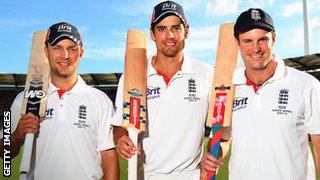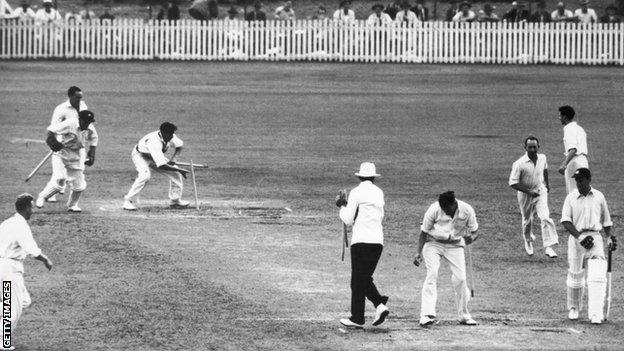Ashes 2013-14: Brisbane ground guide, history and statistics
- Published

Its official name is the Brisbane Cricket Ground, but the famous stadium on Vulture Street in the suburb of Woolloongabba is universally known as the Gabba.
Handed Test status in 1931, the modern Gabba is not quite the "bear pit" of old, and is now capable of holding 42,000 fans in the vast stands encircling the arena in a manner not dissimilar to Melbourne's MCG.
Despite its redevelopment, the "Gabbatoir" remains an intimidating venue, where the Barmy Army trumpeter was ejected in 2006,, external and four years later even fans carrying bags with multiple zips, external fell foul of the entry regulations.
England's poor record in the Queensland heat - only two wins in their last 17 Test visits, in 1978 and 1986 - has cemented Brisbane's place as the traditional first Test venue for each Ashes series.
The Gabba in numbers

BBC Test Match Special statistician Malcolm Ashton presents Brisbane's Ashes records:
Ashes Tests: 19 (Australia won 10, England won four, with five draws)
First Ashes Test: 10-16 February 1933 - a timeless Test, the fourth of the notorious "Bodyline" series. England's hero Eddie Paynter was suffering with tonsillitis when he rose from his hospital bed to make 83 in the first innings, before hitting a six to win the match and regain the Ashes in the second innings.
Highest Ashes total: 645 all out by Australia in November 1946, in the first Ashes Test after World War II. Don Bradman made 187, adding 276 with Lindsay Hassett (128).
Lowest Ashes total: 58 all out by Australia in December 1936. Needing 381 to win, they were skittled in 12.3 overs by England captain Gubby Allen (5-36) and Bill Voce (4-16).

Trott, Cook and Strauss all scored second-innings centuries on England's last Test visit to Brisbane
Highest individual Ashes score: 235 not out by England's Alastair Cook on their last visit in November 2010. His match-saving innings lasted 625 minutes and 428 balls.
Most Ashes runs: 464 by ex-Australia skipper Ricky Ponting, who made two centuries and two fifties on four visits between 1998 and 2010, averaging 92.80.
Best Ashes bowling (innings): 8-71 by legendary Australia leg-spinner Shane Warne in November 1994, when he spun them to a 184-run victory and returned match figures of 11-110.
Most Ashes wickets: 22 by Aussie seamer Glenn McGrath, who collected six-wicket hauls in 1998 and 2006.
Ashes runs scored: 10,500, for the loss of 271 wickets at an average of 38.75 runs per wicket.
Ashes boundaries: 1,073 (1,041 fours, 32 sixes)
Classic Ashes match: First Test, 1950

When Test Match Special listeners hear Geoffrey Boycott hark back to the days of "uncovered pitches", their usual response may be to roll their eyes and reach for the Boycott Bingo cards, external before he moves on to sticks of rhubarb.
But in the "uncovered" days, inclement weather could produce an extraordinary game like the Brisbane Test of 1950 - the Test of retaliatory declarations.
After Australia won the toss and batted, Neil Harvey made 74 as seamers Alec Bedser (4-45) and Trevor Bailey (3-28) restricted them to 228.
England had a long wait for their first innings as day two was completely lost to rain and Sunday was a rest day. The weather relented on the third scheduled day, but the Gabba pitch was the archetypal "sticky dog" and, as Wisden reported,, external "medium-paced bowling of good length presented a well-nigh insoluble problem".
Keith Miller and Bill Johnston wreaked havoc with close fielders surrounding the bat, and England slipped from 49-2 to 57-6 as they struggled to adapt.
Finally, with England 68-7 and trailing by 160, captain Freddie Brown took the only remaining course of action. He declared, in order to get Australia back in on this unplayable pitch.

England's star batsman Len Hutton was kept back in the second innings until the pitch improved
The bold tactic worked brilliantly as the hosts struggled to cope with the uneven bounce generated by Bedser and Bailey. Three wickets fell before Australia had scored a run, and they were soon reeling at 19-5. After only 13.5 overs, Australia were 32-7, but captain Lindsay Hassett retaliated by declaring their second innings, forcing England to bat again - facing a victory target of 193, but with an hour still to survive on the third evening.
Wickets continued to tumble. To save Len Hutton, Denis Compton and himself for day four when the pitch would have dried out, Brown sent in a succession of sacrificial nightwatchmen, to no avail.
A day in which 20 wickets fell for 130 runs finished with England 30-6. Next morning, Hutton scored a majestic unbeaten 62 batting at number eight, but ran out of partners as England were bowled out for 122 to lose by 70 runs.
What happened next? Australia won the series 4-1 with victories in Melbourne, Sydney and Adelaide. England triumphed in the fifth and final Test at Melbourne.
Hutton is remembered as one of the finest batsmen of the 20th century, while uncovered pitches were slowly phased out, bar the odd reappearance in Boycott Bingo.
Champagne moment: 23 November 2006

"The Harmison ball". Three words that still strike fear into any England supporter.
Confidence was high for the 2006-07 series among the thousands of fans who had journeyed down under, although England were missing key men from the class of 2005:, external injured skipper Michael Vaughan and paceman Simon Jones, and opener Marcus Trescothick, who flew home with a recurrence of a stress-related illness., external
Andrew Flintoff, captaining the side in the absence of Vaughan, lost the toss at Brisbane and Ricky Ponting had no hesitation in batting. As in 2005, Harmison was handed the opening over.
But there was to be no repeat of the Durham pace bowler's hostile opening spell at Lord's the previous year, when he struck openers Justin Langer and Matthew Hayden and drew blood when hitting Ricky Ponting on the grille of his helmet.
Instead, Harmison's first ball to Langer was an appalling wide outside off stump which went straight to Flintoff at second slip.
Just as in 2002, when Nasser Hussain invited Australia to bat first in benign conditions,, external England were on the back foot at Brisbane from the word go.
And, just as in 2005, Harmison had set the tone for what was to follow in the series.
"The Harmison ball" has entered cricket legend, setting the standard by which the worst wide deliveries are judged. And if England thought things would improve on that tour, they were sorely mistaken.
What happened next? Langer (82), Ponting (196) and Mike Hussey (86) feasted on England's misfiring attack as Australia racked up 602-9 declared, won the Test by 277 runs and swept to a 5-0 series whitewash.
Harmison remained a Test regular until 2008, when he was dropped in New Zealand., external He played six more Tests after that, the last of which came at The Oval in 2009, ending his international career as an Ashes winner once more. He retired in October 2013.
Statistics correct as of 18 November.
TMS highlights - How the Ashes were won
- Published5 January 2014
- Published15 August 2013
- Published7 August 2013
- Published29 July 2013
- Published17 July 2013
- Published7 July 2013
- Published9 July 2013
- Published2 February 2014